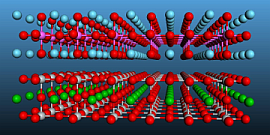Our research is broadly focused on using first-principles calculations and model approaches to predict novel electronic, magnetic, ferroelectric, and transport properties of materials and structures that are interesting from the point of view of new functionalities. We are collaborating with a number of experimental groups at the University of Nebraska and other institutions to correlate our predictions with experimental studies and explore new systems in practice.
Current research areas include:
(i) antiferromangetic spintronics(ii) quantum and topological materials
(iii) 2D van der Waals materials
(iv) interface magnetoelectric effects
(v) ferroelectric and multiferroic tunnel junctions
(vi) 2DEGs at oxide interfaces
(vii) spin-dependent tunneling
(viii) magnetic nanocontacts and nanowires
(ix) interlayer exchange and magnetostatic coupling
Research Areas
Antiferromagnetic Spintronics
Antiferromagnetic spintronics is an emerging field of research, which exploits the Néel vector to control spin- and orbital-dependent transport properties. Due to being robust against magnetic perturbations, producing no stray fields, and exhibiting ultrafast dynamics, antiferromagnets can serve as promising functional materials for spintronic applications... More ...
Interface Magnetoelectric Effects
Control of magnetic properties of materials by an applied electric field, known as magnetoelectric coupling, is interesting for low-power spintronics. There are several known mechanisms responsible for magnetoelectric coupling ... More ...
Spin-Dependent Tunneling
Spin-dependent tunneling is an imbalance in the electric current carried by up- and down-spin electrons tunneling from a ferromagnet through an insulating barrier. A related phenomenon is tunneling magneto-resistance (TMR) that is a change in the resistance of a magnetic tunnel junction (MTJ) when the magnetization of the two ferromagnetic layers changes its alignment. More ...
Quantum &
Topological Materials
Recently, there has been increasing interest in quantum materials, such as topological insulators, Dirac and Weyl semimetals, and
beyond. These materials are characterized by non-trivial fermionic excitations and topologically protected electronic states,
resulting in novel transport properties. More ...
Ferroelectric Tunnel Junctions
Ferroelectric materials are characterized by spontaneous electric polarization that can be switched by an applied electric field. Recent experimental and theoretical findings suggest that ferroelectricity persists down to a nanometer scale, which opens a possibility to use ferroelectric thin films as tunnel barriers in ferroelectric tunnel junctions (FTJs). More ...
Magnetic Nanocontacts
When the dimensions of a metallic conductor are reduced so that they become comparable to the de Broglie wavelengths of the conduction electrons, the conductance becomes quantized. In ferromagnetic metals, the exchange splitting of spin bands leads to spin-dependent conductance quantization and various unusual magnetoresistive phenomena. More ...
2D van der Waals Materials
2D van der Waals (vdW) materials and heterostructures have opened unprecedented opportunities to explore new physics and device concepts. Especially interesting are recently discovered 2D ferroic vdW materials, providing new functionalities associated with switchable spontaneous electric or magnetic polarizations in these materials. More ...
2DEGs at Oxide Interfaces

The discovery of a two dimensional electron gas (2DEG) at the interface between two insulating oxides LaAlO3 and SrTiO3 has attracted significant interest due to possible applications in all-oxide electronic devices. Stimulated by this discovery density-functional calculations are performed to understand properties of 2DEG and explore new functionalities. More ...
Interlayer Coupling
Interlayer coupling in magnetic thin-film layered structures play an important role in controlling their magnetic properties. The coupling may originate from exchange and magnetostatic interactions affecting magnetizations of ferromagnetic films across a non-magnetic spacer layer. For a metallic spacer the interlayer exchange coupling oscillates as a function of its thickness. More ...